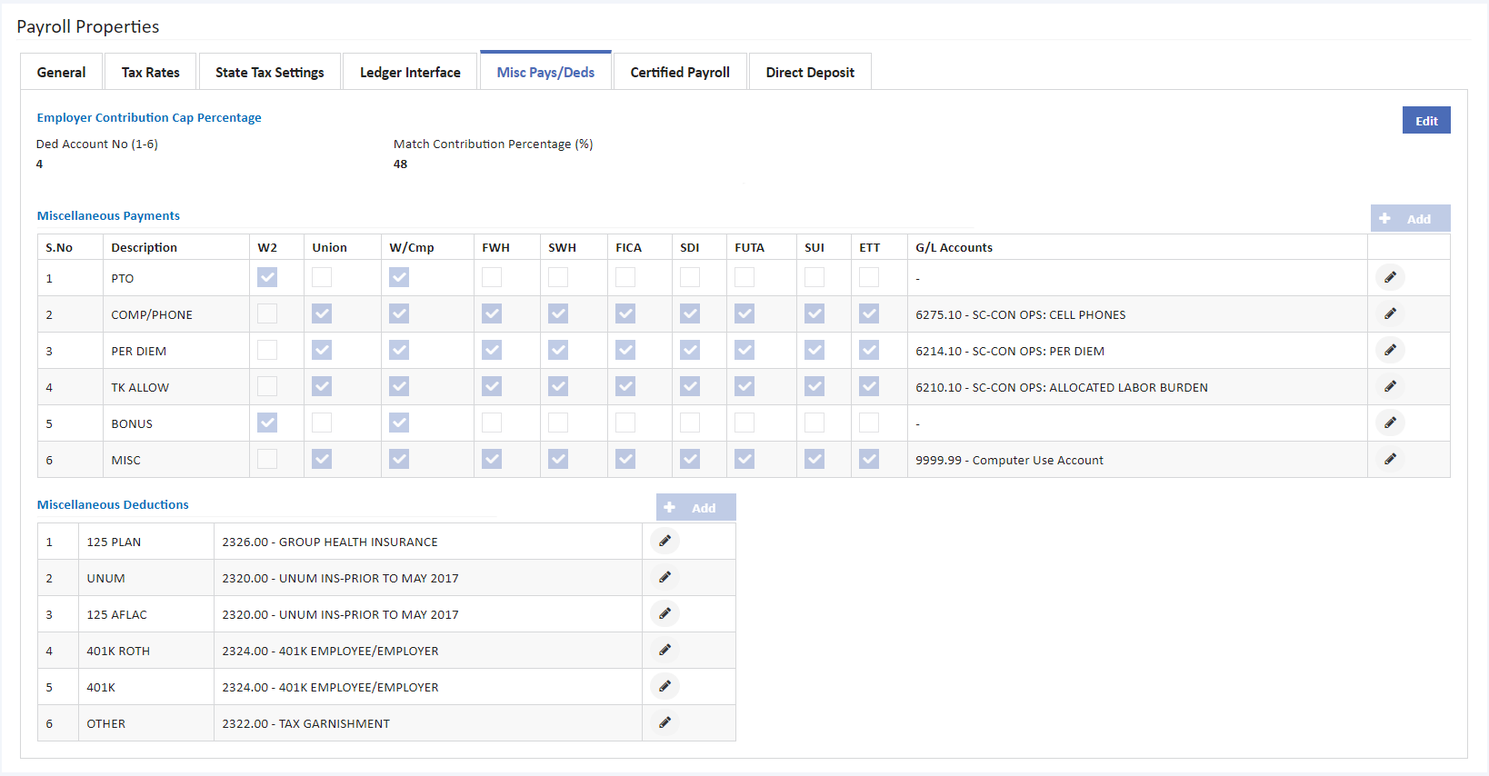The Misc Pays / Deds Tab is used for defining the descriptions of the six miscellaneous pay fields and the six miscellaneous deduction fields that are found on the Properties > Payroll. These descriptions will also be printed on payroll check stubs and on various payroll reports.

Employer Contribution Cap Percentage
- This section of the screen can be used to compute the employer's maximum matching contribution when employers have plans such as Simple IRAs where employee contributions are matched by the employer. These fields can define the specific deduction accumulator that is used for the employees' contribution as well as note the employer's maximum matching contribution percentage.
Please note that a deduction accumulator for the Simple IRA must be established and a Local Deduction Codes must be created to link with the accumulator. The local deduction code may then be linked to each employee. The Simple IRA deduction accumulator MUST NOT be linked with any other local deduction code other than the code(s) established for the Simple IRA.
Miscellaneous Pays
- If a miscellaneous pay item is not set up to be part of the gross wages (the W-2 field is not checked), then the item must be linked to a general ledger account. When the payroll checks are posted through the system, the ledger account linked to the item will be updated with the miscellaneous pay amount.
- If the pay item is set up to be part of the gross wages (the W-2 field is checked), then the amount will post in the general ledger according to the associated department code or to the default Direct Labor or Overhead Labor account, depending on whether the item was coded to a job. The G/L Account fields may be skipped for companies who have not purchased the Ledger system.
- Miscellaneous pay items (those that will be included in gross wages as well as those that are not) may also be set up to be exempt from union benefits and workers compensation insurance.
For example, if you have a misc pay set up for a reimbursement of an expense, the time card entry for this transaction will include the employee's default workers comp code and will calculate workers comp on this pay item, unless you specifically set up this item as exempt from workers comp. If the pay amount is included with the payroll wages (the W-2 field is checked), then the pay item may be set up to be exempt from any of the payroll taxes. Be sure to check with your company's accountant before setting up any pay item as exempt.
Due to the limited space for misc pay items, it is generally recommended that all reimbursements to employees be made through accounts payable rather than the payroll system.
- If your company is union or if you pay prevailing wage, then reserve the first three miscellaneous pay fields and the first three miscellaneous deduction fields for union/prevailing wage items that the employee would receive on their check.
If a pay item, such as union dues, is set up to be withheld from an employee's check, then a corresponding deduct item must also be set up. For example, the Misc Pay 1 field is set up with a description of 'Union Dues'. The Misc Deduct 1 field is set up with a description of 'Dues W/H'. In the Payroll > System > Union option, the union code is set up with a '% of Gross Pay – W/H' pay type for the dues. When a paycheck is processed, the union dues paid to the employee are posted to the 'Union Dues' miscellaneous pay accumulator and the withheld amount is automatically posted to the 'Dues W/H' miscellaneous deduct accumulator.
Other Pay Types: These additional settings help to define how the other pay is processed for the payroll check calculations
|
Hourly - W/H - This option represents the hourly and withheld setting. With this option, the pay amount is included as pay on the employee check, and then also withheld as a deduction. These are typically referred to as In and Out Pay types where the amount shows up as a pay amount on the payroll check and is then deducted from the net amount of the payroll check. |
|---|
|
Hourly - Not W/H - This option represents the hourly and NOT withheld setting and is typically how the other pay transactions are set up. The amount of the other pay is included in the pay amount on the payroll check and NOT withheld from the net amount of the check. |
Transaction Type Settings: The Department Code Advanced Settings are stored in the Department Master Table using the associated time card transaction type for other pays. The various transaction type settings are listed below and are stored Department Master Table:
- 0 -Not Enabled
- 11 - Misc Pay 1 - Hourly - W/H
- 17 - Misc Pay 1 - Hourly - Not W/H
- 12 - Misc Pay 2 - Hourly - W/H
- 18 - Misc Pay 2 - Hourly - Not W/H
- 13 - Misc Pay 3 - Hourly - W/H
- 19 - Misc Pay 3 - Hourly - Not W/H
- 71 - Misc Pay 4 - Hourly - W/H
- 77 - Misc Pay 4 - Hourly - Not W/H
- 72 - Misc Pay 5 - Hourly - W/H
- 78 - Misc Pay 5 - Hourly - Not W/H
Miscellaneous Deductions
The miscellaneous deduct items may be used in conjunction with the Local Deduction Codes which can be used to set up a total of twenty deductions per employee. Be sure to read the documentation on these codes before setting up the six deduction accumulators.
For W2 reporting purposes, pre-tax deductions such as 125 Cafeteria Plans and 401K plans, must be set up with their own miscellaneous deduction accumulator.

 Click Here to download User Guide
Click Here to download User Guide